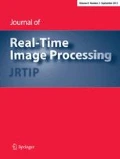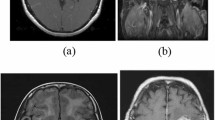Abstract
Classification of brain tumors based on the brain magnetic resonance imaging (MRI) results of patients has become an important problem in medical image processing. A computer program that can efficiently analyze brain MRI images of patients in real time and generate accurate classification results of the tumors in these images can significantly reduce the amount of time needed for diagnosis, which may increase the chances for patients to survive. This paper proposes a new statistical method that can accurately classify three types of brain tumors based on MRI images, the three types of tumors considered include pituitary tumor, glioma, and meningioma. The features for a pixel in an MRI image are obtained by applying a set of convolutional operators to the neighborhood area of the pixel. For training, a hidden Markov model (HMM) is constructed and trained from a training dataset by computing a statistical profile for the feature vectors for pixels in the tumor regions of each type of brain tumors. In addition, a statistical profile is also obtained for pixels that are in the background of a tumor. For classification, the trained HMM is used to assign labels to pixels in an MRI image with a dynamic programming approach and the classification result of the image is obtained from the labels assigned to the tumor region. Both the training and classification processes can be efficiently performed in linear time and does not require the availability of a large amount of computational resources. Experimental results on a large dataset of MRI images show that the proposed method can provide classification results with high accuracy for all three types of brain tumors. A comparison with state-of-the-art methods for brain tumor classification suggests that the proposed method can achieve improved classification accuracy. In addition, real-time analysis also reveals that the proposed approach can probably be used for real-time classification of brain tumors.




Similar content being viewed by others
References
Kaya, I.E., Pehlivanli, A.Ç., Sekizkardes, E.G., Ibrikci, T.: PCA based clustering for brain tumor segmentation of T1w MRI images. Comput. Methods Programs Biomed. 140, 19–28 (2017)
Cheng, J., Huang, W., Cao, S., Yang, R., Yang, W., Yun, Z., Wang, Z., Feng, Q.: Enhanced performance of brain tumor classification via tumor region augmentation and partition. PLoS ONE 10(10), e0140381 (2015)
Siva, R.P.M., Rani, A.V.: Brain tumor classification using a hybrid deep autoencoder with Bayesian fuzzy clustering-based segmentation approach. Biocybern. Biomed. Eng. 40, 440–453 (2020)
Alqudah, A.M., Alquraan, H., Isam, A.Q., Alqudah, A., Al-Sharu, W.: Brain Tumor classification using deep learning technique—a comparison between cropped, uncropped, and segmented lesion images with different sizes. Int. J. Adv. Trends Comput. Sci. Eng. 8(6), 3684–3691 (2019)
Hagargi, A.P., Shubhangi, D.C.: Brain tumor detection and ART classification technique in MR brain images using RPCA QT decomposition. Int. Res. J. Eng. Technol. 5(4), 384 (2018)
Lavanyadevi, R., Machakowsalya, M., Nivethitha, J., Kumar, A.N.: Brain tumor classification and segmentation in MRI images using PNN. In: IEEE International conference on electrical, instrumentation and communication engineering (ICEICE), Karur, India, pp. 1–6 (2017)
Litjens, G., et al.: A survey on deep learning in medical image analysis. Med. Image Anal. Med. Image Anal. 42, 60–88 (2017)
Gordillo, N., Montseny, E., Sobrevilla, P.: State of the art survey on MRI brain tumor segmentation. Magn. Res. Imag. 31(8), 1426–1438 (2013)
Jiang, J., Wu, Y., Huang, M., Yang, W., Chen, W., Feng, Q.: 3D brain tumor segmentation in multimodal MR images based on learning population- and patient-specific feature sets. Comput. Med. Imaging Graph. 37, 512–521 (2013)
Wu, Y., Yang, W., Jiang, J., Li, S., Feng, Q., Chen, W.: Semi-automatic segmentation of brain tumors using population and individual information. J. Digit. Imaging. 26, 786–796 (2013)
Selvaraj, H., Selvi, S.T., Selvathi, D., Gewali, L.: Brain MRI slices classification using least squares support vector machine. Int. J Intell. Comput. Med. Sci. Image Process. 1, 21–33 (2007)
John P.: Brain Tumor classification using wavelet and texture based neural network. Int. J. Sci. Eng. Res. 3(10), 129 (2012)
Zulpe, N., Pawar, V.: GLCM textural features for brain tumor classification. Int. J. Comput. Sci. Issues. 9, 354–359 (2012)
Javed, U., Riaz, M.M., Ghafoor, A., Cheema, T.A.: MRI brain classification using texture features, fuzzy weighting and support vector machine. Prog. Electromagn. Res. B 53, 73–88 (2013)
Yang, W., Feng, Q., Yu, M., Lu, Z., Gao, Y., Xu, Y., et al.: Content-based retrieval of brain tumor in contrastenhanced MRI images using tumor margin information and learned distance metric. Med. Phys. 39, 6929–6942 (2012)
Sasikala, M., Kumaravel, N.: A wavelet-based optimal texture feature set for classification of brain tumours. J. Med. Eng. Technol. 32, 198–205 (2008)
Huang, Z., Du, X., Chen, L., Li, Y., Liu, M., Chou, Y., Jin, L.: Convolutional neural network based on complex networks for brain tumor image classification with a modified activation function. IEEE Access (2020). https://doi.org/10.1109/ACCESS.2020.2993618
Liu D., Liu Y., Dong L.: G-ResNet: Improved resNet for brain tumor classification. In: International conference on neural information processing (ICONIP), Sydney, NSW, Australia, pp. 535–545 (2019)
He, K., Zhang, X. Ren, S., Sun, J.: Deep residue learning for image recognition. In: the IEEE conference on computer vision and pattern recognition (CVPR), Las Vegas, USA, pp. 770–778 (2016)
Anaraki, A.K., Ayati, M., Kazemi, F.: Magnetic resonance imaging based brain tumor grades classification and grading via convolutional neural networks and genetic algorithms. Biocybern. Biomed. Eng. 2019(39), 63–74 (2019)
Das, S., Aranya, O.F.M.R.R., Labiba, N.N.: Brain tumor classification using convolutional neural network. In: International conference on advances in science, engineering and robotics technology (ICASERT), Dhaka, Bangladesh, pp. 1–5 (2019)
Huang, G., Liu, Z.C.N., Maaten, L.V.D., Weinberger, K.Q.: Densely connected convolutional networks. In: The IEEE conference on computer vision and pattern recognition (CVPR), Honolulu, Hawaii, USA, pp. 4700–4708 (2017)
Shi, J., Li, Z., Ying, S., Wang, C., Liu, Q., Zhang, Q., Yan, P.: MR image super-resolution via wide residual networks with fixed skip connection. IEEE J. Biomed. Health 23(3), 1129–1140 (2019)
Sandler, M., Howard, A., Zhu, M., Zhmoginov, A., Chen, L.: MobileNetV2: inverted residues and linear bottlenecks. In: The IEEE conference on computer vision and pattern recognition (CVPR), Salt Lake City, USA, pp. 4510–4520 (2018)
Ma, N., Howard, A., Zhu, M., Zhmoginov, A., Chen, L.: ShuffleNet V2: Practical guidelines for efficient CNN architecture design In: European conference on computer vision (ECCV), Munich, Germany, pp. 116–131 (2018)
Tan, M., Le, Q.: EfficientNet: rethinking model scaling for convolutional neural networks. In: International conference on machine learning (ICML), Long Beach, USA, PMLR 97, pp. 6105–6114 (2019)
Florindo, J., Lee, Y.S., Jun, K., Jeon, G., Albertini, M.: VisGraphNet: a complex network interpretation of convolutional neural features. Inf. Sci. 543, 296–308 (2021)
Wang, S., Govindaraj, V.V., Gorriz, M.J., Zhang, X., Zhang, Y.: Covid-19 classification by FGCNet with deep feature fusion from graph convolutional network and convolutional neural network. Inf. Fusion 67, 208–229 (2021)
Seetha, J., Raja, S.S.: Brain tumor classification using convolutional neural networks. Biomed. Pharmacol. J. 11, 1457–1461 (2018)
Mohsen, H., et al.: Classification using deep learning neural networks for brain tumors. Future Comput. Inf. J. 3, 68–71 (2018)
Ahmad, I., Hussain, F., Khan, S.A., Akram, M.U., Jeon, G.: CPS-based fully automatic cardiac left ventricle and left atrium segmentation in 3D MRI. J. Intell. Fuzzy Syst. 36(5), 4153–4164 (2019)
Widhiarso, W., Yohannes, Y., Cendy, P.: Brain tumor classification using gray level co-occurrence matrix and convolutional neural network. Indones. J. Electron. Instrum. Syst. 8, 179–190 (2018)
Khwaldeh, S., Pervaiz, U., Rafiq, A., Alkhawaldeh, R.S.: Noninvasive grading of glioma tumor using magnetic resonance imaging with convolutional neural networks. Appl Sci. 8(1), 27 (2018)
Özyurt, F., Sert, E., Avci, E., Dogantekin, E.: Brain tumor detection based on Convolutional Neural Network with neutrosophic expert maximum fuzzy sure entropy. Measurement (2019). https://doi.org/10.1016/j.measurement.2019.07.058
Sajjad, M., Khan, S., Muhammad, K., Wu, W., Ullah, A., Baik, S.W.: Multi-grade brain tumor classification using deep CNN with extensive data augmentation. J. Comput. Sci. 30, 174–182 (2019)
Zhang, Y., et al.: Advances in multimodal data fusion in neuroimaging: overview, challenges, and novel orientation. Inf. Fusion 64, 149–187 (2020)
Wu, W., Yang, X., Pang, Y., Peng, J., Jeon, G.: A multifocus image fusion method by using hidden Markov model. Opt. Commun. 287, 63–72 (2013)
Song, Y., Adobah, B., Qu, J., Liu, C.: Segmentation of ordinary images and medical images with an adaptive hidden Markov Model and Viterbi Algorithm. Curr. Signal Transduct. Ther. 15(2), 109–123 (2020)
Wu, S., Wu, W., Yang, X., Lu, L., Liu, K., Jeon, G.: Multifocus image fusion using random forest and hidden Markov model. Soft. Comput. 23(19), 9385–9396 (2019)
Akbarzadeh, O., Khosravi, M.R., Khosravi, B., Halvaee, P.: Medical image magnification based on original and estimated pixel selection models. Med. Eng. Phys. (2018). https://doi.org/10.31661/jbpe.v0i0.797
Alquran, H., Alqudah, A.M., Abu-Qasmieh, I., Al-Badarneh, A., Almashaqbeh, S.: ECG classification using higher order spectral estimation and deep learning techniques. Neural Netw. World 29, 207–219 (2019)
Acknowledgements
G. Li, J, Sun and Y. Song’s work is fully supported by the fund of Specially Appointed Professors of Jiangsu Province, China with the grant number: 1034901701.
Author information
Authors and Affiliations
Corresponding author
Additional information
Publisher's Note
Springer Nature remains neutral with regard to jurisdictional claims in published maps and institutional affiliations.
Rights and permissions
About this article
Cite this article
Li, G., Sun, J., Song, Y. et al. Real-time classification of brain tumors in MRI images with a convolutional operator-based hidden Markov model. J Real-Time Image Proc 18, 1207–1219 (2021). https://doi.org/10.1007/s11554-021-01072-4
Received:
Accepted:
Published:
Issue Date:
DOI: https://doi.org/10.1007/s11554-021-01072-4




